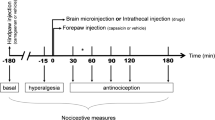Abstract
Pirenperone, a new serotonin antagonist with a selective affinity for the 5-HT2 receptor, was administered in conjunction with tests for the antinociceptive effects of morphine sulphate and electrical brain-stimulation at sites in the periaqueductal gray (PAG) and nucleus raphe magnus (NRM). Nociception was assessed by tail-flick latencies in a warm water bath and pirenperone (0.04–0.16 mg/kg) had no effect on baseline scores. When administered prior to morphine, pirenperone (0.16 mg/kg) caused significant attenuation of analgesia induced by morphine. Comparable effects of pirenperone were observed when analgesia was produced by electrical stimulation of the NRM. In contrast, pirenperone had no effect on the analgesic effects of PAG stimulation. This pattern of results suggests that a system involving supraspinal 5-HT2 receptors may modulate some of the antinociceptive effects of morphine and stimulation of the NRM. The differential effects of pirenperone on stimulation-produced analgesia at sites in the NRM and PAG is consistent with separate neural substrates for the analgesia observed from stimulation of these two brain regions.
Similar content being viewed by others
References
Basbaum AI, Fields HL (1984) Endogenous pain control systems: Brainstem spinal pathways and endorphin circuitry. Ann Rev Neurosci 7:309–338
Berge OG, Fasmer OB, Kjell H (1983) Serotonin receptor antagonists induce hyperalgesia without preventing morphine antinociception. Pharmacol Biochem Behav 19:873–878
Colpaert FC, Janssen PAJ (1983) The head-twitch response to intraperitoneal injection of 5-hydroxytryptophan in the rat: Antagonist effects of purported 5-hydroxytryptamine antagonists and of pirenperone, an LSD antagonist. Neuropharmacology 22:993–1000
Colpaert FC, Niemgeers CJE, Janssen PAF (1982) A drug discrimination analysis of lysergic acid diethylamide (LSD): In vivo agonist and antagonist effects or purported 5-hydroxytryptamine antagonists and of pirenperone, a LSD-antagonist. J Pharmacol Exp Ther 221:206–214
Dickenson AA, Oliveras JL, Besson JM (1979) Role of the nucleus raphe magnus in opiate analgesia as studied by the microinjection technique in the rat. Brain Res 170:95–111
Gorlitz BD, Frey HH (1972) Central monoamines and antonociceptive drug action. Eur J Pharmacol 20:171–180
Green AR, O'Shaughnessy K, Hammond M, Schachter M, Grahame-Smith DG (1983) Inhibition of 5-hydroxytryptamine-mediated behavior by the putative 5-HT2 antagonist pirenperone. Neuropharmacology 22:573–578
Hammond DL, Yaksh TL (1984) Antagonism of stimulation-produced antinociception by intrathecal administration of methysergide or phentolamine. Brain Res 298:329–337
Janssen PAJ (1983) 5-HT2 receptor blockade to study serotonin-induced pathology. TIPS 4:198–206
Leysen JE, Awouters F, Kennis L, Laduron PM, Vandenberk J, Janssen PAJ (1981) Receptor binding profile of R41468, a novel antagonist at 5-HT2 receptors. Life Sci 28:1015–1022
Leysen JE, Niemegeers CJE, Tollenaeize JP, Laduron PM (1978) Serotonergic component of neuroleptic receptors. Nature (Lond.) 272:168–171
Leysen JE, Niemegeers CJE, Van Nueten JM, Laduron PM (1982) [3H] ketanserin (R41468), a selective3H-ligand for serotonin2 receptor binding sites. Mol Pharmacol 21:301–314
Mayer DJ, Wolfle TL, Akil H, Carder G, Liebeskind JC (1971) Analgesia from electrical stimulation in the brainstem of the rat. Science 174:1351–1354
Monroe PJ, Smith DJ (1983) Characterization of multiple [3H] 5-hydroxytryptamine binding sites in rat spinal cord tissue. J Neurochem 41:349–355
Oliveras JL, Bourgoin S, Hery F, Besson JM, Hamon M (1979) A map of serotonergic structures involved in stimulation producing analgesia in unrestrained freely moving cats. Brain Res 164:317–322
Paxinos G, Watson C (1982) The rat brain in stereotaxic co-ordinates. Academic Press, New York
Pellegrino LJ, Cushman AJ (1967) A stereotaxic atlas of the rat brain. Appleton-Century-Crofts, New York
Peroutka SJ, Lebovitz RM, Snyder SH (1981) Two distinct central serotonin receptors with different physiological functions. Science 212:827–829
Peroutka SJ, Snyder SH (1979) Multiple serotonin receptors: Differential binding of [3H] 5-hydroxytryptamine, [3H] lysergic acid diethylamide and [3H] spiroperidol. Mol Pharmacol 16:687–699
Plotkin KE, Thorn-Gray BE (1983) The neurochemical mechanism for stimulation-produced analagesia: Comparison of tests involving tonic and phasic pain. Neurosci Abst 9:261.2
Proudfit HK, Hammond DL (1981) Alterations in nociceptive threshold and morphine-induced analgesia produced by intrathecally administered amine antagonists. Brain Res 218:393–399
Reynolds DV (1969) Surgery in the rat during analgesia induced by focal brain stimulation. Science 164:444–445
Satoh M, Akaike A, Nakazawa T, Takagi H (1980) Evidence for involvement of separate mechanism in the production of analgesia by electrical stimulation of the nucleus reticularis paragigantocellularis and nucleus raphe magnus in the rat. Brain Res 194:525–529
Shiomi H, Takagi H (1974) Morphine analgesia and bulbospinal noradrenergic system: Increase in the concentration of normetanephrine in the spinal cord of the rat caused by analgesia. Br J Pharmacol 52:519
Yaksh TL (1979) Direct evidence that spinal serotonin and noradrenaline terminals mediate the spinal antinocieceptive effects of morphine in the periaqueductal gray. Brain Res 160:180–185
Yaksh TL, DuChateau JC, Rudy TA (1976) Antagonism by methysergide and cinanserin of the antinociceptive action of morphine administered into the periaqueductal gray. Brain Res 104:367–372
Yeung JC, Yaksh TL, Rudy T (1977) Concurrent mapping of brain stem sites for sensitivity to the direct application of morphine and focal electrical stimulation in the production of antonociception in the rat. Pain 4:23–40
Author information
Authors and Affiliations
Rights and permissions
About this article
Cite this article
Paul, D., Phillips, A.G. Selective effects of pirenperone on analgesia produced by morphine or electrical stimulation at sites in the nucleus raphe magnus and periaqueductal gray. Psychopharmacologia 88, 172–176 (1986). https://doi.org/10.1007/BF00652235
Received:
Revised:
Issue Date:
DOI: https://doi.org/10.1007/BF00652235



